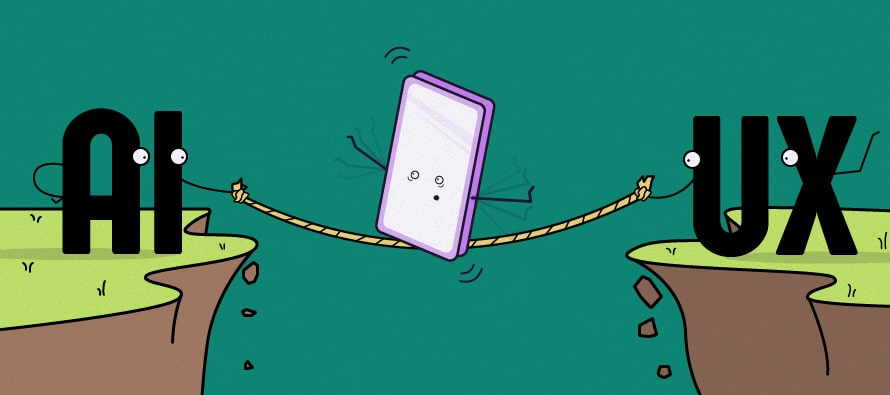It is often thought that once a good design is made it needs to be learned by the user. The digital age is posing an opportunity for the existence of a different kind of design – where the design learns about the user behavior and modifies itself.
What opens up is a plethora of new possibilities for both technologists and designers.
Hari Nallan & Mohita Jaiswal - February 2020 - Updated December 2022

Design which facilitates learnability
- Earlier providing an easy to learn interface has been of great importance. Designers have always found creative ways to accelerate the user’s learning curve through a design which facilitates learnability. For eg., while composing a tweet on twitter a user can hover over one of the icons below the text field, to know what action the icon allows, letting the design speak for itself rather than adding text.
- Familiarity brings consistency. For eg., Google uses its own design system which is increasingly used across all of its products. Therefore, a call-to-action button will be the same across tools. Such a familiarity eases the adoption process of a new interface as users are able to transfer their mental model of one product onto another.
- Providing feedback during the learning process helps. This can enable a user to remember the interface better as they immediately learn what is possible or not.
An advent of AI
Most people generally treat AI as a technology that takes away the human from the equation and is improving convenience and productivity. What AI stands for – is a process when a machine mimics cognitive functions such as learning and problem-solving, without really “understanding” or “learning” like humans do. The AI just follows the human instructions it is programmed to follow and will improve itself while doing so through iterative data analysis.

Within AI-enabled UI, the AI has the ability to understand user’s commands and present the user with the best possible predictions based on all the available data it has. For designers foraying in this area, the requirement is to make the interaction with the AI easy to use, simple and efficient so users can easily accomplish their goals. The challenge designers face now is how to design AI-enabled UI which users can trust with their personal data.
This is one impact area and challenge that AI has brought for the design domain. What it has also opened up in its place is a whole new world of the possibility of an adaptive and learnable design opportunity.
Possibilities for Design – What to expect when Design becomes learnable in itself?
1. Redefining of Personas
Personas are known to be archetypical users whose goals and characteristics represent the needs of a larger group of users. A learnable design would view personas in a new light; where the persona is a state of mind of the user at a particular instant.
Here Persona becomes a combination of – context * event * behavior
If the context is – a media company launches a new episode and wants users to watch it. A chain of events and behaviors could be triggered through this.
Personas are known to be archetypical users whose goals and characteristics represent the needs of a larger group of users. A learnable design would view personas in a new light; where the persona is a state of mind of the user at a particular instant.
Here Persona becomes a combination of – context * event * behavior
If the context is – a media company launches a new episode and wants users to watch it. A chain of events and behaviors could be triggered through this.
Event 1: Notification of users through emails.
Another event (Event 2) could be sharing an advertisement for the show.
Depending upon the context and event different user behaviors could be shown. Mapping and accounting for each of these permutation would become a cornerstone for a learnable design ecosystem.

2. Creation of an adaptive, machine learning-powered UI
One of the most obvious examples of how machine learning could be used in UX is through adaptivity. This could manifest as products that learn how a person uses them and then changes to accommodate that person. When we accommodate design for different trigger events and associated behavior changes, we build designs suitable to the state of mind a user is in. Adaptive design makes way for changes in wireframing techniques to embed an iterative approach to create an ever-evolving possibility of wireframes or sketches.
3. Understanding of how user journeys cannot happen linearly
When the design needs to learn, it becomes irrelevant to draw a user journey. Traditionally, the experience of a digital service follows predefined user journeys with clear states and actions. Until recently, it has been the designer’s job to create these linear workflows and transform them into understandable and unobtrusive experiences.
4. Interspersing of design with analytics
According to interaction designer and Carnegie Mellon professor John Zimmerman, there’s a gaping chasm between AI and UX when designers fail to see opportunities where machine learning can add value,” as shared at the Google People + AI Research Symposium in Massachusetts. The future calls out for design education to include courses in machine learning to bridge this gap. It will also become common to pair design students with data science students, so they get the opportunity to work with someone making models and have the opportunity to experience the kinds of problems machine learning can solve. Learnable design would stand on the plinth of prediction models and design, becoming an area of interdisciplinary research.

5. Empowerment of designers with an advanced toolkit
For interfaces to learn, new design tools would need to make way into the designer’s toolkits. With an opportunity lying in front of different design softwares, a platform which allows designers to prototype and plan adaptive interfaces will enable a new era altogether. Designers would need to become more comfortable with designing for uncertain outcomes when services rely more algorithms based on probabilities. It will become important for designers in this new role to consider how to architect and communicate a range of outcomes rather than specific ones.
An ‘Inspiring’ Way forward
As design steps up to meet this new tipping point in the digital era, the role of the designer will also encompass – Capturing data of the user, interpreting the data, analyzing behavior, creating models, rendering probabilistic adaptive design and measuring the learnability of this design. A mark of a design with good learnability capabilities should see an increase in efficiency while repeating tasks.




